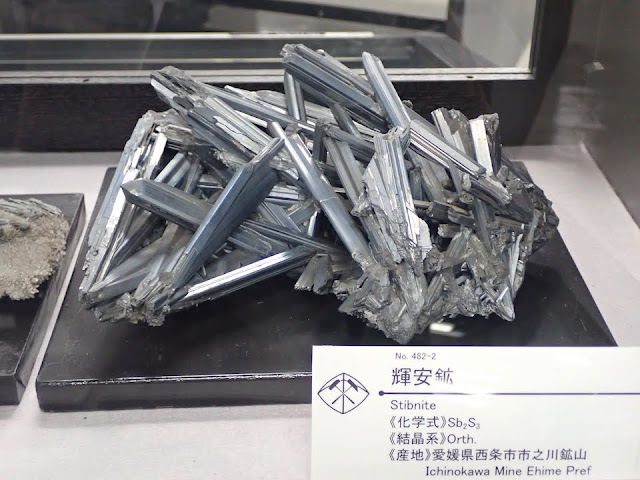秋田大学鉱業博物館 Mineral Industry Museum of Akita University
展示品の一つ、愛媛県市ノ川鉱山産の輝安鉱(No. 482)。市ノ川の輝安鉱をみればその博物館のレベルがわかる、と言われているかどうか定かではないが、これは及第点を与えていい標本だろう。
A group of stibnite crystals from the Ichinokawa mine (Saijo city, Ehime prefecture, Japan). I am not sure if anybody says that mineral museum can be graded by the quality of the Ichinokawa stibnite, but anyway this is fairly a marvelous specimen.
秋田大学鉱業博物館を訪れた。「ミシュランガイド」の三ツ星レストランとはそこの料理を味わうためだけにその町を訪れる価値がある、という意味だそうだが、鉱物好きの人にとっては、この博物館に行くためだけに秋田を訪れてもいいと言ったら言いすぎだろうか。ともかく鉱物、地質、鉱山関係の展示が充実した博物館である。
I visited Mineral Industry Museum, Akita University. A three-star restaurant of Michelin Guide means that it is worth planning a journey just for having a dinner there. I think this is a three-star museum for mineral lovers.
秋田県は金・銀・銅・鉛などの金属資源だけでなく、石油や天然ガス資源にも恵まれている。これらは明治以降さかんに開発され、近代日本の発展を支えた。こうした「鉱業」の技術者を養成するために、秋田県内で鉱山を経営していた財閥企業の助力で秋田鉱山専門学校が創建されたのが1910年(明治43年)のこと。その「列品室」がこの博物館の前身になる。列品室は戦時中に火災にあったため、秋田の鉱山がもっとも盛んだった明治後期〜昭和初期の貴重な標本はほとんど失われた。しかし学校卒業生や鉱山会社の寄付などにより再び地元秋田をはじめ、世界の地質・鉱物標本があつめられ、現在に至っている。ちなみに秋田鉱山専門学校は戦後秋田大学鉱山学部へと看板が変わり、現在は国際資源学部と名を変えている。「鉱山学」を教える大学は数あれど、独立した「鉱山学部」の名前の学部があるのは日本では秋田大だけであり、地域の資源に根ざした特色ある大学といえよう。
Akita is abundant in metal resources such as gold, silver, copper and lead, and also in oil and natural gas. These resources were exploited on a large scale since the 19th century to accelerate modernization of Japan. The museum is originated from the exhibition room of Akita Mining Professional School, which was built in 1910 with the help of the mining companies. The exhibition room and many valuable specimens collected from the 19th to the early 20th century were destroyed by fire in the wartime. However, the museum was rebuilt after the war by Department of Mining Science, Akita University, with the cooperation of the alumni and the mining companies. Akita University is unique in Japan for having a separated school of mining science, which has been named School of International Resource Sciences.
建物は秋田大学のメインキャンパスを見下ろす手形山の丘の上にたつ。秋田駅東口から北へ 2 km ほどのところで、徒歩だと約 30 分。秋田駅西口から「大学病院ゆき」のバスに乗って「鉱業博物館入口」で降りる手もあるが、1時間に1本くらいしか走ってない。バス時刻が合わなければ行きはタクシーで行って(1000円くらい)、帰りは大学のキャンパスの中などぶらぶら散歩して戻る、くらいがちょうどよいかもしれない。
The museum is located on a Tegata-Yama hill, about 2 km from East Gate of JR Akita Station to the north. There is a public bus transportation from the station (about once an hour).
円筒形の丸い建物で、展示室は3フロアに分かれている。1階は鉱物・鉱石標本が大半を占めていて、わたしにとってはもっとも興味のある展示室だ。何しろ標本数が膨大なので、一個一個じっくり見ているとたちまち時間が過ぎてしまう。
There are three floors in the rounded museum building. The first floor exhibits mineral specimens that most interest me. There are so many specimens that time passes fast.
A large specimen from Osarizawa mine, Kazuno city, Akita. The sphalerite crystals are reddish and translucent.
A group of mostly twinned calcite from Arakawa mine, Daisen city, Akita. Such twinned calcite is also known from Kushikino mine, Kagoshima.
A large specimen from a quartz and copper vein of Miyatamata mine, Daisen city, Akita. There is Amethyst around the lower-right part.
Triangular and triangular needle chalcopyrite from Miyatamata mine viewed from the side.
2階は地質・岩石標本が主で、広い意味で地学博物館になっている。3階は鉱山・油田開発(採掘、製錬など)に関する展示がある。このフロアで秋田の黒鉱鉱山(おそらく大館市松峰鉱山)の開発の様子をおさめた古い記録映像がながれていた。以前、大館市郷土博物館を訪れたときにさまざまな採掘・運搬機械が展示されていたのを目にしたが、実際に動いているところを見たことがなかったので興味深かった。鉱石を運搬する機械が圧縮空気で動いていた。
There are rock and geological specimens in the second floor. The third floor is devoted to exhibitions of mining and smelting industry. I saw an old documentary video recording the development of a kuroko-type mine in Odate city. The mining machine, which I saw at Odate City Museum, was driven by compressed air.


Snapshots of a documentary video.
A model of timbering.
An illustration of Innai silver mine (Yuzawa city, Akita) painted in 1856. The miners sit in a vertical line to convey water upward. A more complete image can be seen at the website of Akita University library.
わたしがこどもの頃訪れたときにはもっと古びた建物で、暗い展示室の蛍光灯のスイッチを自分で入れて、見終わったら消す、みたいなところだったと記憶するが、いまでは内装が新しくなって、だいぶ近代化(?)されている。受付のところでは鉱物標本やグッズなどもすこし売っている。「鑛のきらめき」(悠雲社、2014)という展示品の解説書が出ている。一時品切れだったらしいが、再版されていて受付で購入できる。ふつうの本屋では取り扱っていないようで、アマゾンでは7000円近い価格で古本が売られている。通販はしてないみたいだが、熱意をもって連絡すれば郵送してくれるんじゃないだろうか。






